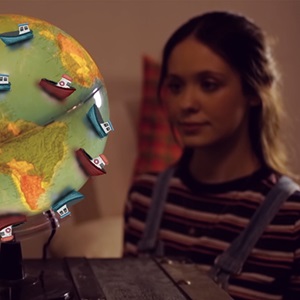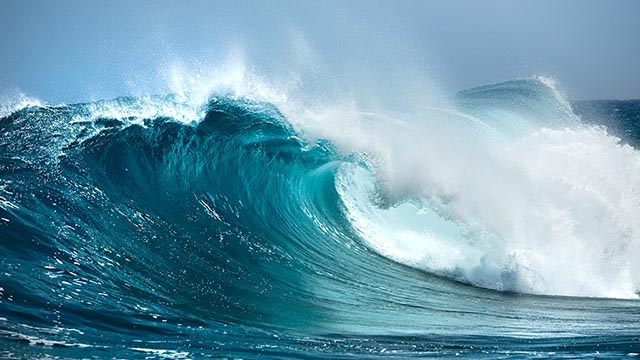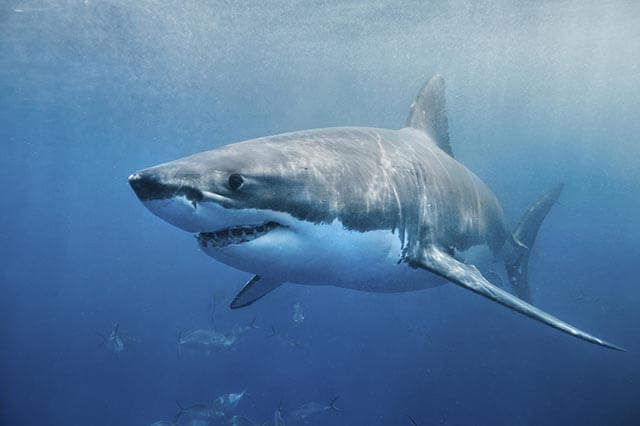Promote ocean literacy during Sea Week and inspire students to learn about the ocean.
About Sea Week Aotearoa New Zealand
Join us for Sea Week (1-9 March 2025) as we promote ocean literacy and celebrate connecting with our ocean.
Sea Week is a great opportunity to improve our collective understanding of the ocean's influence on us and our influence on the ocean.
Marine scientists answer some great questions from kids
Watch the video playlist or browse the questions below.
That's a really great question because everyone has heard about how fish are supposed to have these three-second memories, kind of like Dory from Finding Nemo, but in fact, most fish and sharks can remember things for weeks, months, and even years, and that means they can actually find their way really easily back to important places. So, for example, salmon can remember the smell of the stream where they were born, which helps them find their way back when they're ready to lay their own egg. And lots of fish can remember landmarks like coral reefs and underwater rock formations and use those to find their way home. Some sharks can even find their way when travelling across whole oceans, probably by learning patterns in the Earth's magnetic field, and then using those like a map. So yeah, fishing sharts can remember where they've been and also how to find them again when they leave.
Let's picture this: you are a fish cruising through a coral reef, for example, and as you swim, you might notice a human shape gliding through the water, but what do they see exactly? So fish including sharks, might not see colours the same way we, do but they are experts at spotting movement and contrast. So when they look at you they will likely notice your outline and also how you're moving through the underwater world.
Well, we do know that fish can hear.
They have specialised structures in their ears called otoliths, and they can definitely hear sounds at very low frequencies compared to terrestrial animals, which can hear sounds at higher or more diverse frequencies.
Fish finders, I think, use a much higher frequency, so I don't think the fish can hear the frequencies of the fish finders themselves, although it probably varies by species.
But what we do know, another fun fact about fish, is that not only can they hear, but they can also sing. A lot of fish use different sounds to vocalize where they're at, whether they're protecting their territory, if they're alerting others to predators or perhaps finding a mate.
Well contrary to popular beliefs where sharks can smell blood like a mile or two miles away, it's actually only probably a few hundred meters. You know blood has to travel through the water, similar to how smells travel through the air, and sharks have very sensitive senses of smell, but it's not enough to pick up one drop of blood in the water. But yeah, the smell is one of their many senses; They have got really good eyesight, they've got a really good sense of smell, but probably the best thing they have is once they get close to prey, they have lots of sensory organs around their nose and face called ‘ampullae of Lorenzini’. They use that as almost like a sixth sense to feel the electro pulses off another animal. So things like hammerheads for example, they've got a really wide head - they kind of use that like a metal detector, like you see someone down the beach and they sweep their head from side to side finding prey in the sand. So yeah, smell is one of their senses, but they've got other awesome ones as well.
Well, at the end it's really about personality and preference, just like with us humans!
For instance, clownfish, like Nemo from the movies, they're very social, they’re always hanging out in coral reefs and even peeking out to greet
snorkelers.
And also, the wrasse for example, who might swim right up to say hello, checking out the action with their curious eyes.
But some others are very quiet, very shy and they prefer to stay away from all this. This is the case of the seahorses.
Well, sharks use their fins sort of like how dogs use their tails. So you can kind of tell a dog's mood or behaviour by how its tail’s going. If it's wagging, it’s really happy to see you. You can tell that if it's sort of straight out, and they're growling at you, and their chest is out, you know they're probably pretty angry.
Sharks aren't too dissimilar actually, if they're just cruising around with their fins in a normal position, just kind of swimming slowly, they're all good. But when they start to sort of push their chest out, and curl their pectoral fins around, and put their head down, you know that they're a bit angry - especially if they come zooming in past you or they start to aggressively do sweeps back and forth in the water. You know they're getting a bit angry. But their fins can give that away, by how they're holding them.
It's a really good question so the answer is a bit different depending on whether you're a fish or a whale. So fish, they're really well adapted to the aquatic environment but with a very special organ called a ‘swim bladder’ and this is like a balloon.
If you imagine if you squeeze a balloon, the air is coming out and so when this balloon is in the fish, it starts to sink. However, if it wants to rise again then it can expand its swim bladder - it can expand this balloon with more air - then it can rise.
Whales are a bit different. They're mammals like you and I, and they breathe air, so they have lungs. So when they want to dive, they need to let go of this air in their lungs, otherwise they'll just remain at the surface. So as they start to dive, their body starts to squeeze all that air out, and they can sink. Then, when they want to come to the surface, they have to use their big fins, like the pectoral ones on their side, and their tail fin at the back, and that pushes them back towards the surface where they can take a big breath.
There are many different species of fish in the ocean.
Most scientists estimate that there are about 20,000 different kinds of fish in the sea. But the truth is we really don't know because we keep discovering new species as we explore more of the ocean.
There are small species like the clown fish which is the star of Finding Nemo.
There's really big species like the whale shark which is actually the biggest fish in the sea.
There are some fish that are truly living fossils, like the coelacanth, but there is another one that has been around for more time than any other fish. Its first records date over 400 million years, and it has survived four massive extinction events.
This is a fish that resembles a big earthworm but has vertebrae and a skull, but no jaw. This is the lamprey or vampire fish. This fish has a creepy circular mouth, like this one, with twelve rows of teeth. This mouth has inspired many movie monsters. It is known as a vampire fish because it uses this mouth to latch onto its prey and pierce their scales and skin, and feed on its blood and fluids. When it attaches it’s very likely that its prey will die.
But from a lamprey-like fish and after millions of years of random mutations and natural selection it gave rise not only to bony fishes, but also to rays and sharks, and the rest of the vertebrates. This is amazing!
Great question! Most of the deep ocean is unexplored because it's super dark and really hard for humans to get to, but we know that deep-sea animals have awesome adaptations that help them survive where the sunlight can't reach.
Unlike most land animals almost all deep-sea animals have the power to glow in the dark. This is called ‘bioluminescence’.
This superpower helps them hunt, communicate, find mates, or protect themselves in the pitch black.
Like female anglerfish who have a glowing lantern dangling from the top of their heads to lure prey into their terrifying daggertooth mouths. Or Parapandalus - a deep sea shrimp that throws up bioluminescent vomit to ward off its predators. And some fish have big, glowing googly eyes to help them see better. Like this guy, the barreleye fish, whose luminous tube eyes point up through a giant clear dome on top of its head.
Each deep-sea mission marine biologists are finding more fantastic beasts and we're realizing the deep blackness is actually a world full of light.
Fish look like fish because they have special bodies to help them swim.
Their streamlined bodies have fins to help them steer and give them balance, they have scales to protect them and their tails help them move.
Each fish has its own special colouring and shape which helps it hide, from perhaps bigger fish which are after them, or to help it catch its food but also to help it find a companion underwater.
Fish also have gills which help them breathe and help them survive in their watery homes.
It's worth checking out the Ocean Sunfish which looks like a flattened pancake underwater.
Well just like you and me fish need to eat to survive and fish of different kinds and of different sizes each have preferred things to eat.
So for example if I'm a big shark that likes to eat mackerel, herring, and cod what happens if the herring disappears? Well I'll have to eat more mackerel and cod to sustain myself.
And if all other big sharks do the same herring and cod will become too few and we will starve and there will also be less fish for other predators that like to eat mackerel and cod so they will also starve and because these species are connected through what they eat when one species decreases or goes extinct all are affected.
It's a really good question and it starts millions of years ago when whales were evolving. As they evolved, they became absolute professionals at catching very small types of animals. Some prefer to catch small fish and some preferred to catch krill, which are like small shrimp-like animals.
So if we look at the blue whale, the largest animal to ever have lived, it started to specialise on krill. To catch krill, it's a lot easier to do that if you have a very fine-meshed net, so blue whales developed this. And if you think about what a blue whale's mouth looks like, it has these long baleen plates along the top, that act like a sieve, when it's trying to catch the krill.
It developed this very special way of hunting, called ‘lunge feeding’, where it opens its mouth incredibly wide, and scoops up all the krill from the water. The size of the animal is really important - because it's got such a big mouth, it needs a very long body to support it.
Also, krill don't all live in the same place. Whales might have to travel hundreds of miles to catch some krill. To do that they need to be incredibly efficient, and also have big reserves of fat, to keep them going before they find their food. And therefore you end up with a very big animal.
It's got to be big enough to make these long journeys to find the food and have a big enough mouth in order to catch it.
Kahoot! Quizzes
Ocean Connections - How we are connected with ocean
Take this Kahoot quiz to your knowledge about our connection and interdependence with the ocean and seas.
Kararehe o te wai / Sea Creatures
Can you identify these sea creatures using a common Māori name?

A-Z of sustainable oceans & fisheries
Search our library of curriculum-aligned ocean-centred education resources by topic or keyword to find activities, unit plans, film clips, worksheets and PowerPoint slides.

The National Aquarium of New Zealand
Check out a range of ways to celebrate Seaweek with the National Aquarium of New Zealand.

Download ocean related teaching resources
Explore our extensive library of ocean and sustainable fishing related resources.



